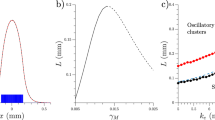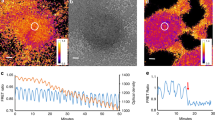Abstract
The amoebae Dictyostelium discoideum aggregate after starvation in a wavelike manner in response to periodic pulses of cyclic AMP (cAMP) secreted by cells which behave as aggregation centers. In addition to autonomous oscillations, the cAMP signaling system that controls aggregation is also capable of excitable behavior, which consists in the transient amplification of suprathreshold pulses of extracellular cAMP. Since the first theoretical model for slime mold aggregation proposed by Keller and Segel in 1970, many theoretical studies have addressed various aspects of the mechanism and function of cAMP signaling in Dictyostelium. This paper presents a brief overview of these developments as well as some reminiscences of the author's collaboration with Lee Segel in modeling the dynamics of cAMP relay and oscillations. Considered in turn are models for cAMP signaling in Dictyostelium, the developmental path followed by the cAMP signaling system after starvation, the frequency encoding of cAMP signals, and the origin of concentric or spiral waves of cAMP.
Similar content being viewed by others
References
Alcantara, F., Monk, M., 1974. Signal propagation during aggregation in the slime mould D. discoideum. J. Gen. Microbiol. 85, 321–334.
Alon, U., Surette, M.G., Barkai, N., Leibler, S., 1999. Robustness in bacterial chemotaxis. Nature 397, 168–171.
Barchilon, M., Segel, L.A., 1988. Adaptation, oscillations and relay in a model for cAMP secretion in cellular slime molds. J. Theor. Biol. 133, 437–446.
Bretschneider, T., Siegert, F., Weijer, C.J., 1995. Three-dimensional scroll waves of cAMP could direct cell movement and gene expression in Dictyostelium slugs. Proc. Natl. Acad. Sci. USA 92, 4387–4391.
Dallon, J.C., Othmer, H.G., 1997. A discrete cell model with adaptive signaling for aggregation of D. discoideum. Philos. Trans. R. Soc. Lond. B Biol. Sci. 352, 391–417.
Dallon, J.C., Othmer, H.G., 2004. How cellular movement determines the collective force generated by the D. discoideum slug. J. Theor. Biol. 231, 203–222.
Darmon, M., Brachet, P., Pereira da Silva, L.H., 1975. Chemotactic signals induce cell differentiation in D. discoideum. Proc. Natl. Acad. Sci. USA 72, 3163–3166.
Devreotes, P., 1989. D. discoideum: a model system for cell-cell interactions in development. Science 245, 1054–1058.
Devreotes, P.N., Sherring, J.A., 1985. Kinetics and concentration dependence of reversible cAMP-induced modification of the surface cAMP receptor in Dictyostelium. J. Biol. Chem. 260, 6378–6384.
Dinauer, M., Steck, T.L., Devreotes, P.N., 1980. Cyclic 3′,5′ AMP relay in D. discoideum. V. Adaptation of the cAMP signaling response during cAMP stimulation. J. Cell Biol. 86, 554–561.
Dormann, D., Vasiev, B., Weijer, C.J., 1998. Propagating waves control D. discoideum morphogenesis. Biophys Chem. 72, 21–35.
Eichinger, L. et al., 2005. The genome of the social amoeba D. discoideum. Nature 435, 43–57.
Gerisch, G., 1968. Cell aggregation and differentiation in Dictyostelium. Curr. Top. Dev. Biol. 3, 157–197.
Gerisch, G., Fromm, H., Huesgen, A., Wick, U., 1975. Control of cell contact sites by cAMP pulses in differentiating Dictyostelium cells. Nature 255, 547–549.
Gerisch, G., Hess, B., 1974. Cyclic-AMP controlled oscillations in suspended Dictyostelium cells: their relation to morphogenetic cell interactions. Proc. Natl. Acad. Sci. USA 71, 2118–2122.
Gerisch, G., Malchow, D., Roos, W., Wick, U., 1979. Oscillations of cyclic nucleotide concentrations in relation to the excitability of Dictyostelium cells. J. Exp. Biol. 81, 33–47.
Gerisch, G., Wick, U., 1975. Intracellular oscillations and release of cyclic AMP from Dictyostelium cells. Biochem. Biophys. Res. Commun. 65, 364–370.
Glansdorff, P., Prigogine, I., 1971. Thermodynamics of Structure, Stability and Fluctuations. Wiley, New York.
Goldbeter, A., 1975. Mechanism for oscillatory synthesis of cyclic AMP in D. discoideum. Nature 253, 540–542.
Goldbeter, A., 1980. Models for oscillations and excitability in biochemical systems. In: Segel, L.A., (Ed.), Mathematical Models in Molecular and Cellular Biology. Cambridge Univ. Press, Cambridge, pp. 248–291.
Goldbeter, A., 1996. Biochemical Oscillations and Cellular Rhythms. Cambridge Univ. Press, Cambridge, UK.
Goldbeter, A., 2004. Computational biology: A propagating wave of interest. Curr. Biol. 14, R601-R602.
Goldbeter, A., Caplan, S.R., 1976. Oscillatory enzymes. Annu. Rev. Biophys. Bioeng. 5, 449–476.
Goldbeter, A., Erneux, T., Segel, L.A., 1978. Excitability in the adenylate cyclase reaction in D. discoideum. FEBS Lett. 89, 237–241.
Goldbeter, A., Koshland, D.E. Jr., 1982. Simple molecular model for sensing and adaptation based on receptor modification, with application to bacterial chemotaxis. J. Mol. Biol. 161, 395–416.
Goldbeter, A., Segel, L.A., 1977. Unified mechanism for relay and oscillations of cyclic AMP in D. discoideum. Proc. Natl. Acad. Sci. USA 74, 1543–1547.
Goldbeter, A., Segel, L.A., 1980. Control of developmental transitions in the cyclic AMP signaling system of D. discoideum. Differentiation 17, 127–135.
Gundersen, R.E., Johnson, R., Lilly, P., Pitt, G., Pupillo, M., Sun, T., Vaughan, R., Devreotes, P.N., 1989. Reversible phosphorylation of G-protein-coupled receptors controls cAMP oscillations in Dictyostelium. In: Goldbeter, A. (Ed.), Cell to Cell Signaling: From Experiments to Theoretical Models. Academic Press, London, pp. 477–488.
Halloy, J., Lauzeral, J., Goldbeter, A., 1998. Modeling oscillations and waves of cAMP in Dictyostelium cells. Biophys. Chem. 72, 9–19.
Höfer, T., Sherratt, J.A., Maini, P.K., 1995. D. discoideum: Cellular self-organization in an excitable biological medium. Proc. R. Soc. Lon. B 259, 249–257.
Jacquet, M., Renault, G., Lallet, S., De Mey, J., Goldbeter, A., 2003. Oscillatory nucleocytoplasmic shuttling of the general stress response transcriptional activators Msn2 and Msn4 in Saccharomyces cerevisiae. J. Cell Biol. 161, 497–505.
Keller, E.F., Segel, L.A., 1970. Initiation of slime mold aggregation viewed as an instability. J. Theor. Biol. 26, 399–415.
Knox, B.E., Devreotes, P.N., Goldbeter, A., Segel, L.A., 1986. A molecular mechanism for sensory adaptation based on ligand-induced receptor modification. Proc. Natl. Acad. Sci. USA 83, 2345–2349.
Konijn, T.M., Van de Meene, J.G.C., Bonner, J.T., Barkley, D.S., 1967. The acrasin activity of adenosine 3′,5′-cyclic phosphate. Proc. Natl. Acad. Sci. USA 58, 1152–1154.
Laub, M.T., Loomis, W.F., 1998. A molecular network that produces spontaneous oscillations in excitable cells of Dictyostelium. Mol Biol Cell. 9, 3521–3532.
Lauzeral, J., Halloy, J., Goldbeter, A., 1997. Desynchronization of cells on the developmental path triggers the formation of waves of cAMP during Dictyostelium aggregation. Proc. Natl. Acad. Sci. USA 94, 9153–9158.
Levchenko, A., Iglesias, P.A., 2002. Models of eukaryotic gradient sensing: application to chemotaxis of amoebae and neutrophils. Biophys. J. 82, 50–63.
Levine, H., Aranson, I., Tsimring, L., Truong, T.V., 1996. Positive genetic feedback governs cAMP spiral wave formation in Dictyostelium. Proc. Natl. Acad. Sci. USA 93, 6382–6386.
Li, Y.X., Goldbeter, A., 1989. Frequency specificity in intercellular communication: The influence of patterns of periodic signaling on target cell responsiveness. Biophys. J. 55, 125–145.
Li, Y.X., Goldbeter, A., 1990. Frequency encoding of pulsatile signals of cyclic AMP based on receptor desensitization in Dictyostelium cells. J. Theor. Biol. 146, 355–367.
Li, Y.X., Goldbeter, A., 1992. Pulsatile signaling in intercellular communication: Periodic stimuli are more efficient than random or chaotic signals in a model based on receptor desensitization. Biophys. J. 61, 161–171.
Lin, C.C., Segel, L.A., 1988. Mathematics Applied to Deterministic Problems in the Natural Sciences. SIAM Publications, USA.
Loomis, W.F., 1979. Biochemistry of aggregation in Dictyostelium. Dev. Biol. 70, 1–12.
Loomis, W.F., 1996. Genetic networks that regulate development in Dictyostelium cells. Microbiol. Rev. 60, 135–150.
Ma, L., Janetopoulos, C., Yang, L., Devreotes, P.N., Iglesias, P.A., 2004. Two complementary, local excitation, global inhibition mechanisms acting in parallel can explain the chemoattractant-induced regulation of PI(3,4,5)P3 response in Dictyostelium cells. Biophys. J. 87, 3764–3774.
Macnab, R.M., Koshland, D.E. Jr., 1972. The gradient sensory mechanism in bacterial chemotaxis. Proc. Natl. Acad. Sci. USA 69, 2509–2512.
Maeda, M., Lu, S., Shaulsky, G., Miyazaki, Y., Kuwayama, H., Tanaka, Y., Kuspa, A., Loomis, W.F., 2004. Periodic signaling controlled by an oscillatory circuit that includes protein kinases ERK2 and PKA. Science 304, 875–878.
Manahan, C.L., Iglesias, P.A., Long, Y., Devreotes, P.N., 2004. Chemoattractant signaling in D. discoideum. Annu. Rev. Cell Dev. Biol. 20, 223–253.
Marée, A.F., Hogeweg, P., 2001. How amoeboids self-organize into a fruiting body: Multicellular coordination in D. discoideum. Proc. Natl Acad. Sci. USA 98, 3879–3883.
Marée, A.F., Hogeweg, P., 2002. Modeling Dictyostelium discoideum morphogenesis: The culmination. Bull. Math. Biol. 64, 327–353.
Martiel, J. L, Goldbeter, A., 1987. A model based on receptor desensitization for cyclic AMP signaling in Dictyostelium cells. Biophys. J. 52, 807–828.
Nanjundiah, V., 1988. Periodic stimuli are more successful than randomly spaced ones for inducing development in D. discoideum. Biosci. Rep. 8, 571–577.
Nanjundiah, V., 1997. Models for pattern formation in the Dictyostelid slime molds. In: Maeda, Y., Inouye, K., Takeuchi, I., (Eds.), Dictyostelium: A Model System for Cell and Developmental Biology. University Academy Press, Tokyo, pp.
Nanjundiah, V., 1998. Cyclic AMP oscillations in D. discoideum: Models and observations. Biophys. Chem. 72, 1–8.
Nicolis, G., Prigogine, I., 1977. Self-Organization in Nonequilibtrium Systems. Wiley, New York.
Odell, G.M., Bonner, J.T., 1986. How the D. discoideum grex crawls. Philos. Trans. R. Soc. Lond. 312, 487–525.
Palsson, E., Cox, E.C., 1996. Origin and evolution of circular waves and spirals in D. discoideum territories. Proc. Natl Acad. Sci. USA 93, 1151–1155.
Palsson, E., Lee, K.J., Goldstein, R.E., Franke, J., Kessin, R.H., Cox, E.C., 1997. Selection for spiral waves in the social amoebae Dictyostelium. Proc. Natl. Acad. Sci. USA 94, 13719–13723.
Parnas, H., Segel, L.A., 1978. A computer simulation of pulsatile aggregation in D. discoideum. J. Theor. Biol. 71, 185–207.
Roos, W., Nanjundiah, V., Malchow, D., Gerisch, G., 1975. Amplification of cyclic-AMP signals in aggregating cells of D. discoideum. FEBS Lett. 53, 139–142.
Roos, W., Scheidegger, C., Gerisch, G., 1977. Adenylate cyclase oscillations as signals for cell aggregation in D. discoideum. Nature 266, 259–261.
Rossomando, E.F., Sussman, M., 1973. A 5′-adenosine monophosphate-dependent adenylate cyclase and an adenosine 3′,5′-cyclic monophosphate-dependent adenosine triphosphate pyrophosphohydrolase in D. discoideum. Proc. Natl. Acad. Sci. USA 70, 1254–1257.
Sawai, S., Thomason, P.A., Cox, E.C., 2005. An autoregulatory circuit for long-range self-organization in Dictyostelium cell populations. Nature 433, 323–326.
Segel, L.A., 1984. Modeling Dynamic Phenomena in Molecular and Cellular Biology. Cambridge Univ. Press, Cambridge.
Segel, L.A., 2001. Computing an organism. Proc. Natl. Acad. Sci. USA 98, 3639–3640.
Segel, L.A., Goldbeter, A., 1994. Scaling in biochemical kinetics: Dissection of a relaxation oscillator. J. Math. Biol. 32, 147–160.
Segel, L.A., Goldbeter, A., Devreotes, P.N., Knox, B.E., 1986. A mechanism for exact sensory adaptation based on receptor modification. J. Theor. Biol. 120, 151–179.
Shaffer, B.M., 1962. The acrasina. Adv. Morphog. 2, 109–182.
Tomchik, K.J., Devreotes, P.N., 1981. Adenosine 3′,5′-monophosphate waves in D. discoideum: A demonstration by isotope dilution-fluorography. Science 212, 443–446.
Vasiev, B., Weijer, C.J., 2003. Modeling of D. discoideum slug migration. J. Theor. Biol. 223, 347–359.
Weijer, C.J., 2004. Dictyostelium morphogenesis. Curr. Opin. Genet. Dev. 14, 392–398.
Author information
Authors and Affiliations
Corresponding author
Rights and permissions
About this article
Cite this article
Goldbeter, A. Oscillations and waves of cyclic AMP in Dictyostelium: A prototype for spatio-temporal organization and pulsatile intercellular communication. Bull. Math. Biol. 68, 1095–1109 (2006). https://doi.org/10.1007/s11538-006-9090-z
Received:
Accepted:
Published:
Issue Date:
DOI: https://doi.org/10.1007/s11538-006-9090-z




